INTRO
REGION
LINKS
SHOPS
EVENTS
|
|
HOME INTRO |
VISIT REGION |
MEDIA LINKS |
TOUR SHOPS |
NEWS EVENTS |
|---|---|---|---|---|---|
EBT Fall Spectacular 2000 / FEBT 18th Reunion | |||||
< Back to the EBTRR Homepage
< Back to the EBTRR Multimedia Archive
Page Contents:
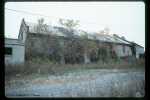 In Woodvale, the mine #6 Boiler House
still stands to service a mine long gone.
In Woodvale, the mine #6 Boiler House
still stands to service a mine long gone.
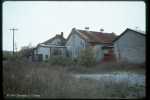 Between the Boiler House and the Dynamo House is the
Engine House, which, like its
counterpart in Robertsdale, provided the mechanical work to operate the
mine cables. This one serviced Mine #6,
the shaft mine.
Between the Boiler House and the Dynamo House is the
Engine House, which, like its
counterpart in Robertsdale, provided the mechanical work to operate the
mine cables. This one serviced Mine #6,
the shaft mine.
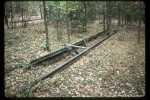 This is the Ash Pit outside the
Robertsdale Enginehouse. Like its
Mount Union counterpart, the
enginehouse had an ash pit on only one of the two tracks.
This is the Ash Pit outside the
Robertsdale Enginehouse. Like its
Mount Union counterpart, the
enginehouse had an ash pit on only one of the two tracks.
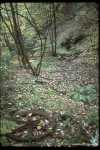 One of the cable spindles for Mine #1
still survives in the brush near the mine entrance.
One of the cable spindles for Mine #1
still survives in the brush near the mine entrance.
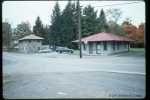 EBT's Robertsdale Station and
the Rockhill Iron and Coal Post Office
now serve as a museum for the
Friends of the East Broad Top.
EBT's Robertsdale Station and
the Rockhill Iron and Coal Post Office
now serve as a museum for the
Friends of the East Broad Top.
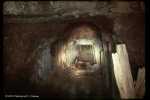 This is a 30 second exposure of the interior of the
Wrays Hill Tunnel, taken from
the safety of the concrete lined portal. It is all to clear why
it is unwise to enter the tunnel. A little of the far portal can
just be made out.
This is a 30 second exposure of the interior of the
Wrays Hill Tunnel, taken from
the safety of the concrete lined portal. It is all to clear why
it is unwise to enter the tunnel. A little of the far portal can
just be made out.
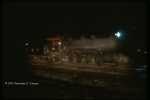 This night photo of #16 out for display was taken using a long exposure
and a high powered light.
This night photo of #16 out for display was taken using a long exposure
and a high powered light.
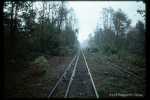 In Mount Union, morning mists still drift across the narrow rails.
As the mists clear, so does the gloom upon the rail as wheels will
soon ply them once again.
In Mount Union, morning mists still drift across the narrow rails.
As the mists clear, so does the gloom upon the rail as wheels will
soon ply them once again.
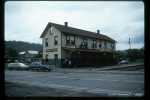 In Rockhill, preparations include cleanup work on
Orbisonia Station.
In Rockhill, preparations include cleanup work on
Orbisonia Station.
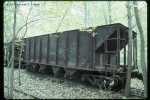 In the trees at the south end of the Rockhill yard lies the EBT's only
four bay hopper, an experiment and the last to be built of the original
hopper construction program.
In the trees at the south end of the Rockhill yard lies the EBT's only
four bay hopper, an experiment and the last to be built of the original
hopper construction program.
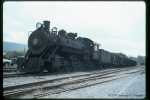 The star of the show, #16 is on display in preparation for the
spectacular the next day. She's coupled to about eight of the
restored hoppers. Frank Shoup and the other RTY volunteers
deserve the credit for this.
The star of the show, #16 is on display in preparation for the
spectacular the next day. She's coupled to about eight of the
restored hoppers. Frank Shoup and the other RTY volunteers
deserve the credit for this.
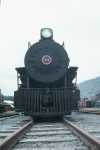 Up close and personal with #16.
Up close and personal with #16.
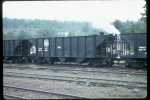 Hopper 994 sets in line behind #16 to represent a period coal drag.
Hopper 994 sets in line behind #16 to represent a period coal drag.
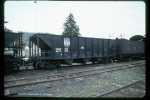 Hopper 951 has the honor to be placed right behind the tender.
Hopper 951 has the honor to be placed right behind the tender.
 M-7 is spotted next to #16 for a test of the air compressor powered
whistle. The air line can be seen going over the back of the tender
to a tank in the coal bunker.
M-7 is spotted next to #16 for a test of the air compressor powered
whistle. The air line can be seen going over the back of the tender
to a tank in the coal bunker.
 A Railways to Yesterday track crew installs ties in track five to
ensure the safe parking of M-7. The crew members are (L to R)
Henry Long (on the spike maul), unknown (on the spike puller),
Phil Glass (M-1 and M-7 engineer), Phil Raynes (M-1 and M-7 conductor),
and Joel Salmon (RTY President).
A Railways to Yesterday track crew installs ties in track five to
ensure the safe parking of M-7. The crew members are (L to R)
Henry Long (on the spike maul), unknown (on the spike puller),
Phil Glass (M-1 and M-7 engineer), Phil Raynes (M-1 and M-7 conductor),
and Joel Salmon (RTY President).
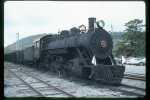 Now ready for the event, #16 sports flags and fresh trim and roof
paint, courtesy of RTY.
Now ready for the event, #16 sports flags and fresh trim and roof
paint, courtesy of RTY.
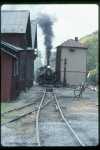 #17, out to loosen up for tomorrow's runs, smokes up a storm by
the Sand House.
#17, out to loosen up for tomorrow's runs, smokes up a storm by
the Sand House.
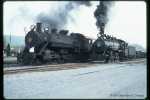 As sisters #15 and #16 pass, the former's smoke trail nearly makes
the latter look alive. It seems strange to see #16 in common carrier
garb with american flags on the front and #15 in tourist era garb
without them.
As sisters #15 and #16 pass, the former's smoke trail nearly makes
the latter look alive. It seems strange to see #16 in common carrier
garb with american flags on the front and #15 in tourist era garb
without them.
 As they pass, the difference in size between the two locomotives
becomes more apparent.
As they pass, the difference in size between the two locomotives
becomes more apparent.
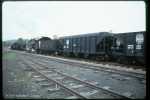 As #15 with hoppers passes #16 and her display coal drag, it nearly
looks like 1955 again in Rockhill Furnace.
As #15 with hoppers passes #16 and her display coal drag, it nearly
looks like 1955 again in Rockhill Furnace.
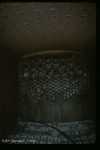 The interior of #16's firebox looks pretty clean.
The interior of #16's firebox looks pretty clean.
 One last shot of #16 and her charge before the crowds shuffle in
tomorrow.
One last shot of #16 and her charge before the crowds shuffle in
tomorrow.
 #14 rolls out Saturday morning past the
Car Shop
to take the freight train for the day.
#14 rolls out Saturday morning past the
Car Shop
to take the freight train for the day.
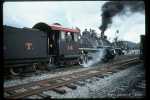 #14, at engineer Tom Holder's command, manuvers in beside #15
to hook up to the freight train. To the
right is the last hopper in #16's static consist.
#14, at engineer Tom Holder's command, manuvers in beside #15
to hook up to the freight train. To the
right is the last hopper in #16's static consist.
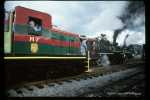 M-7, with Phil Glass at the helm and Phil Raynes on the rail,
passes the steamers on the way to park near #16.
M-7, with Phil Glass at the helm and Phil Raynes on the rail,
passes the steamers on the way to park near #16.
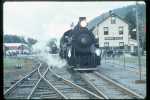 The second train, the Shade Gap Picnic Train, prepares
to depart the station behind #14. #16 stands back on the
adjacent track and #17 spews steam into the air in the distance
of the main.
The second train, the Shade Gap Picnic Train, prepares
to depart the station behind #14. #16 stands back on the
adjacent track and #17 spews steam into the air in the distance
of the main.
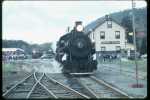 As #14 and train depart, M-1 has been fired up and is preparing to
move to the station.
As #14 and train depart, M-1 has been fired up and is preparing to
move to the station.
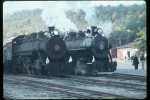 #17 steams past her slightly senior sister. The peculiar design
of #17's modified kerosene headlight contrasts with #16's newer
electric era one. Its blue tint makes it look even newer than that.
#17 steams past her slightly senior sister. The peculiar design
of #17's modified kerosene headlight contrasts with #16's newer
electric era one. Its blue tint makes it look even newer than that.
 From this angle the similarities of the two locomotives are apparent.
Curiously, #16 seems to lack one of #17's grab irons on the smokebox.
From this angle the similarities of the two locomotives are apparent.
Curiously, #16 seems to lack one of #17's grab irons on the smokebox.
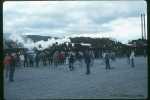 The crowd gathers for the noon whistle salute.
The crowd gathers for the noon whistle salute.
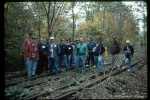 Saturday afternoon, FEBT held a tour of the
Mount Union Yard for attendees of
the FEBT Fall Reunion. Those who had not wandered off by the end of
the tour gathered for a photo on top of the
Mount Union Yard Culvert.
Saturday afternoon, FEBT held a tour of the
Mount Union Yard for attendees of
the FEBT Fall Reunion. Those who had not wandered off by the end of
the tour gathered for a photo on top of the
Mount Union Yard Culvert.
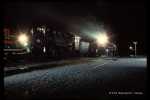 During the night photo session #16 and #15 are lit up for the
photo line.
During the night photo session #16 and #15 are lit up for the
photo line.
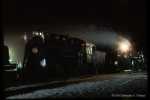 During this long exposure #16's flags kept on fluttering.
During this long exposure #16's flags kept on fluttering.
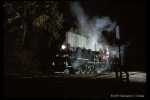 At the Coal Dock #15 is lit
up with crew members on the pilot and in the cab.
At the Coal Dock #15 is lit
up with crew members on the pilot and in the cab.
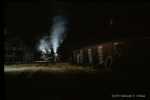 In the distance, #15 approaches the
Carpentry Shop
and slips down the shop track toward the roundhouse.
In the distance, #15 approaches the
Carpentry Shop
and slips down the shop track toward the roundhouse.
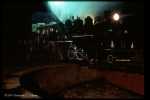 #15 at the Ash Pit. Not such
a great photo, but an excellent effect with the steam.
#15 at the Ash Pit. Not such
a great photo, but an excellent effect with the steam.
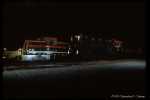 Night falls on the new and the old. M-7 and #18 are lit up with
the remaining flash pack after the formal photo shoot ended.
Night falls on the new and the old. M-7 and #18 are lit up with
the remaining flash pack after the formal photo shoot ended.
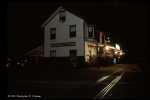 With the last power of the flash packs, a few pulses illuminated
Orbisonia Station.
With the last power of the flash packs, a few pulses illuminated
Orbisonia Station.
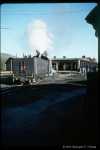 #17 prepares for the day over the
Ash Pit as eager spectators
look on.
#17 prepares for the day over the
Ash Pit as eager spectators
look on.
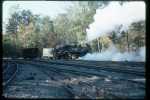 Sunday morning is unusually brisk, even for October, making the
show of steam that much more 'Spectacular'.
Sunday morning is unusually brisk, even for October, making the
show of steam that much more 'Spectacular'.
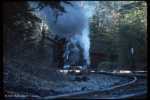 #17 waters up near the Coal Docks
while continuing to vent steam from her open cylinder cocks.
#17 waters up near the Coal Docks
while continuing to vent steam from her open cylinder cocks.
 Slowly departing after her drink, #17 creeps northward within a
veil of her own steam.
Slowly departing after her drink, #17 creeps northward within a
veil of her own steam.
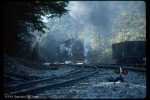 The veil tightens as she picks up speed.
The veil tightens as she picks up speed.
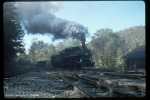 At last the steam lifts as the black lady hits stride.
At last the steam lifts as the black lady hits stride.
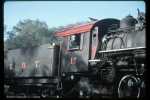 The engineer remains vigilant as the locomotive passes, destined for
service.
The engineer remains vigilant as the locomotive passes, destined for
service.
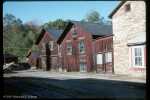 The Storehouses behind the
Farm House lack the right
angles they once had, but continue to serve their intended purpose.
The Storehouses behind the
Farm House lack the right
angles they once had, but continue to serve their intended purpose.
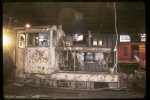 Within the Locomotive Shop
a battered Plymouth switcher awaits a return to service that will
be a long time coming. Behind it one of three clones to the M-7
also play ladies in waiting.
Within the Locomotive Shop
a battered Plymouth switcher awaits a return to service that will
be a long time coming. Behind it one of three clones to the M-7
also play ladies in waiting.
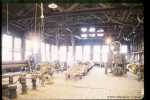 A long exposure in the Boiler
Shop reveals a plethora of equipment on display. To the left
are a collection of railroad jacks lined up beside two welding
machines. Center is a baggage cart in front of several gas powered
maintenance cars. To the right is the huge Niles punch and shear
machine.
A long exposure in the Boiler
Shop reveals a plethora of equipment on display. To the left
are a collection of railroad jacks lined up beside two welding
machines. Center is a baggage cart in front of several gas powered
maintenance cars. To the right is the huge Niles punch and shear
machine.
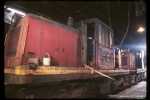 Back in the Locomotive Shop
two GE centercabs, twins of M-7, wait, hoping service is in their
futures.
Back in the Locomotive Shop
two GE centercabs, twins of M-7, wait, hoping service is in their
futures.
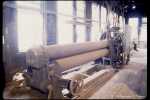 The massive
Power Roll in the
Boiler Shop was used to create sheets like those used in
tank car #116.
The massive
Power Roll in the
Boiler Shop was used to create sheets like those used in
tank car #116.
 Near the Power Roll is this smaller
Hand Roll to perform the same job on a smaller scale.
Near the Power Roll is this smaller
Hand Roll to perform the same job on a smaller scale.
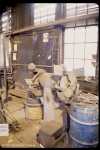 Across the shop this hefty grinder is still in service for the railroad.
Across the shop this hefty grinder is still in service for the railroad.
 Down the wall this Pipe Threader
has been adapted to an electric motor to keep it in service.
Down the wall this Pipe Threader
has been adapted to an electric motor to keep it in service.
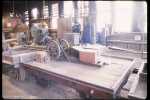 This is one of two gas powered maintenance cars in the
Boiler Shop. It may have
been a conversion from a mechanical handcar.
This is one of two gas powered maintenance cars in the
Boiler Shop. It may have
been a conversion from a mechanical handcar.
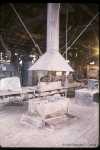 A forge is an indispensable tool on any railroad, for it is
not without reason they call it the Iron Horse. This is the
only forge in the main complex of buildings.
A forge is an indispensable tool on any railroad, for it is
not without reason they call it the Iron Horse. This is the
only forge in the main complex of buildings.
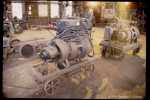 The EBT's two antique welding machines look good for their
age. The EBT was primarily a rivet operations, but two welded
tenders reveal the EBT was not above modern technology.
The EBT's two antique welding machines look good for their
age. The EBT was primarily a rivet operations, but two welded
tenders reveal the EBT was not above modern technology.
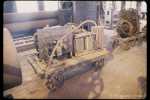 The rear of the second welder reveals the exposed circuitry of
the machine.
The rear of the second welder reveals the exposed circuitry of
the machine.
 An antique sickle bar grass cutter powered by a single
cylinder gas engine. It is setting on top of a track
maintenance trailer.
An antique sickle bar grass cutter powered by a single
cylinder gas engine. It is setting on top of a track
maintenance trailer.
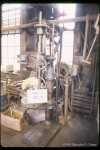 Another conversion to an independent electric motor, this
drill press is surrounded by drill filings, testament to its
continued use.
Another conversion to an independent electric motor, this
drill press is surrounded by drill filings, testament to its
continued use.
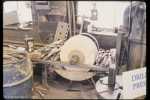 Beside the drill press, this large stone grinder would likely
have been used to keep the drill bits sharp.
Beside the drill press, this large stone grinder would likely
have been used to keep the drill bits sharp.
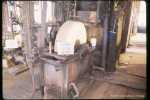 With the previous grinder in the background, this truely large
emery wheel grinder stands five feet high and would handle the
largest grinding jobs in the shops.
With the previous grinder in the background, this truely large
emery wheel grinder stands five feet high and would handle the
largest grinding jobs in the shops.
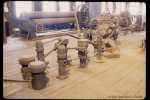 Here is a closer view of the railroad jacks in the center of the
Boiler Shop.
Here is a closer view of the railroad jacks in the center of the
Boiler Shop.
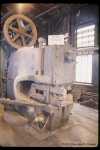 This is the punch end of the big Niles-Bement-Pond
Punch and Shear.
This is the punch end of the big Niles-Bement-Pond
Punch and Shear.
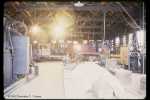 This is an overall shot of the
Boiler Shop interior
looking toward the Locomotive Shop.
This is an overall shot of the
Boiler Shop interior
looking toward the Locomotive Shop.
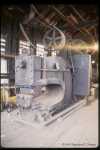 This is the opposite shear end of the big Niles-Bement-Pond
Punch and Shear.
This is the opposite shear end of the big Niles-Bement-Pond
Punch and Shear.
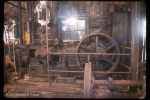 Nestled in a corner of the
Locomotive Shop is the steam driven air compressor for
the shops complex.
Nestled in a corner of the
Locomotive Shop is the steam driven air compressor for
the shops complex.
 Front and center in the
Locomotive Shop is the large
Locomotive Wheel Lathe. The
wheel set on display is much smaller than the sets usually
turned in such a large machine.
Front and center in the
Locomotive Shop is the large
Locomotive Wheel Lathe. The
wheel set on display is much smaller than the sets usually
turned in such a large machine.
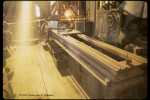 This lathe was used for the machining of the surfaces on
brake cylinders, the devices on railcars that apply air from
the air brake lines against the brake shoes.
This lathe was used for the machining of the surfaces on
brake cylinders, the devices on railcars that apply air from
the air brake lines against the brake shoes.
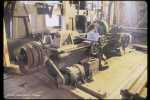 Another of the many lathes, this is the one was used to machine
the surface of axles before the similarly machined wheels
were pressed on by the machine to the left of this lathe.
Another of the many lathes, this is the one was used to machine
the surface of axles before the similarly machined wheels
were pressed on by the machine to the left of this lathe.
 This unique machine is the only
Slotter in the shops.
This unique machine is the only
Slotter in the shops.
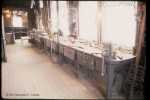 In the Machine Shop,
this is the main workbench. Even today a disassembled
locomotive dynamo (generator) awaits repair.
In the Machine Shop,
this is the main workbench. Even today a disassembled
locomotive dynamo (generator) awaits repair.
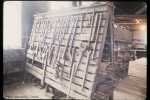 Wrenches, their design varied as the landscape, await
the next nut to turn. Events still call these
veteran tools off their pegs even today.
Wrenches, their design varied as the landscape, await
the next nut to turn. Events still call these
veteran tools off their pegs even today.
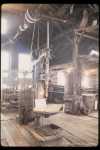 Drills, like lathes, were a tool constantly in need in a
railroad shop. This one is in the
Machine Shop.
Drills, like lathes, were a tool constantly in need in a
railroad shop. This one is in the
Machine Shop.
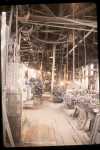 From the rear, the Machine Shop
is a plethora of belts, machines and parts awaiting their turn
through the shops.
From the rear, the Machine Shop
is a plethora of belts, machines and parts awaiting their turn
through the shops.
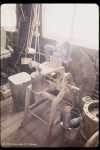 In the far reaches of the Machine Shop,
this small grinding wheel would be for finer work than the other grinders.
In the far reaches of the Machine Shop,
this small grinding wheel would be for finer work than the other grinders.
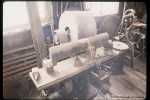 Beside the small grinder is another one for specialty use.
Beside the small grinder is another one for specialty use.
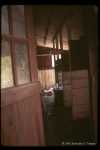 Machinists have needs too. Attached to the
Boiler Shop is a four
hole privey for the relief of the shops workers.
Machinists have needs too. Attached to the
Boiler Shop is a four
hole privey for the relief of the shops workers.
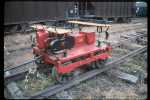 Restored in 1984 by Bruce Saylor and a team of FEBT volunteers,
the 'spider' gas maintenance car was brought out for display
for the first time since 1996. She did not run due to a damaged
spark plug which was being rebuilt by RTY member Phil Glass.
Restored in 1984 by Bruce Saylor and a team of FEBT volunteers,
the 'spider' gas maintenance car was brought out for display
for the first time since 1996. She did not run due to a damaged
spark plug which was being rebuilt by RTY member Phil Glass.
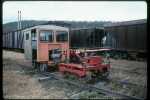 The Spider and the EBT's enclosed Fairmont car pose together
near the trolley museum.
The Spider and the EBT's enclosed Fairmont car pose together
near the trolley museum.
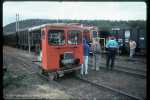 A nearly identical car, this one was sold off in the 60's or
70's and later purchased by RTY member Phil Raynes. He is
restoring it and brings it each year to display at the Fall
Spectacular.
A nearly identical car, this one was sold off in the 60's or
70's and later purchased by RTY member Phil Raynes. He is
restoring it and brings it each year to display at the Fall
Spectacular.
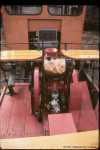 This is a closeup of the Spider's engine.
This is a closeup of the Spider's engine.
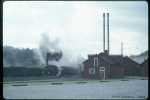 #14 passes the shops buildings with the passenger train. She is
the first locomotive to arrive for the Sunday Whistle Salute.
#14 passes the shops buildings with the passenger train. She is
the first locomotive to arrive for the Sunday Whistle Salute.
 #15, #17 and #14 are lined up for the Sunday Whistle Salute.
#12 is in the rear.
#15, #17 and #14 are lined up for the Sunday Whistle Salute.
#12 is in the rear.
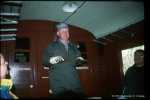 Phil Glass, RTY member and M-1 engineer and caretaker, explains
the rocking motion of M-1 is due to her 'cut down' plans from a
standard gauge car that did not include updated suspension.
Phil Glass, RTY member and M-1 engineer and caretaker, explains
the rocking motion of M-1 is due to her 'cut down' plans from a
standard gauge car that did not include updated suspension.
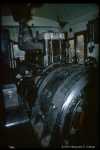 In the front compartment of the M-1, the 1928 Brill engine and
Westinghouse generator crank away to keep the car moving.
In the front compartment of the M-1, the 1928 Brill engine and
Westinghouse generator crank away to keep the car moving.
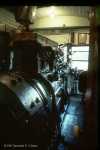 On the opposite side of the engine room is the seat for the
engineer. The position offers little protection from the
noise of the engine.
On the opposite side of the engine room is the seat for the
engineer. The position offers little protection from the
noise of the engine.
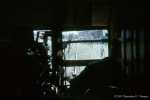 Things are afoot in Rockhill when M-1 returns.
Things are afoot in Rockhill when M-1 returns.
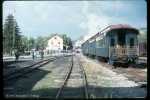 The passenger train waits in the yard as the Shade Gap Picnic Train
boards at the station.
The passenger train waits in the yard as the Shade Gap Picnic Train
boards at the station.
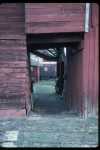 "TOP of the world, ma!" M-1 heads to the stable and is briefly
visible between the Boiler House and the Foundry.
"TOP of the world, ma!" M-1 heads to the stable and is briefly
visible between the Boiler House and the Foundry.
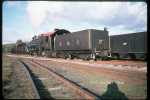 After dropping her train, #17 heads toward the roundhouse.
After dropping her train, #17 heads toward the roundhouse.
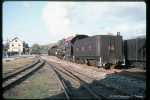 After dropping her train in turn, #14 follows suit after #17
and heads for the barn.
After dropping her train in turn, #14 follows suit after #17
and heads for the barn.
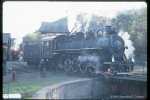 #17 gets a cleaning at the Ash Pit
while #14 waits her turn at the
Inspection Pit.
#17 gets a cleaning at the Ash Pit
while #14 waits her turn at the
Inspection Pit.
 For those of you who have wondered what your intrepid author
looks like, here is your chance. No, I'm not as young as
I look, trust me.
For those of you who have wondered what your intrepid author
looks like, here is your chance. No, I'm not as young as
I look, trust me.
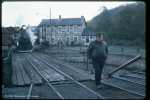 The man and the machine. Without the machine, man is without
ability. Without the man, the machine is but cold steel. Together
they can move mountains.
The man and the machine. Without the machine, man is without
ability. Without the man, the machine is but cold steel. Together
they can move mountains.
Richard Morgan crosses the turntable ahead of #17 preparing to
use his booming voice to clear the spectators from the path of
her blowdown valve. Rich passed away in March of 2001 of a
sudden stroke. It is the people of the EBT who have granted her
such a unique character, and without them, she becomes but cold steel.
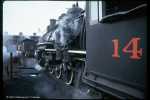 The life drains from #17 as her steam escapes from her blowdown
valve. Soon she will receive a push from #14 into her stall, the
latter taking the balance of trains for the season. #17 will
doze and have her scars mended until she reemerges
to battle gravity in another season.
The life drains from #17 as her steam escapes from her blowdown
valve. Soon she will receive a push from #14 into her stall, the
latter taking the balance of trains for the season. #17 will
doze and have her scars mended until she reemerges
to battle gravity in another season.
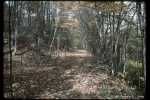 South of Rockhill, an early branch off the EBT. The
Booher Branch serviced an iron
mine on Blacklog Mountain.
South of Rockhill, an early branch off the EBT. The
Booher Branch serviced an iron
mine on Blacklog Mountain.
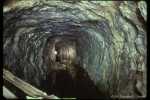 Another long exposure, this time of
Sideling Hill Tunnel reveals how much better shape it is in than
Wrays Hill Tunnel.
Another long exposure, this time of
Sideling Hill Tunnel reveals how much better shape it is in than
Wrays Hill Tunnel.
|
HOME |
The East Broad Top Railroad Homepage © 1994-2003 Christopher D. Coleman All rights reserved Site Information Top of this page |
|---|